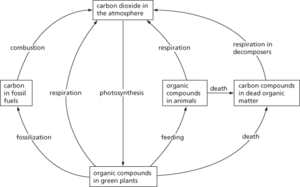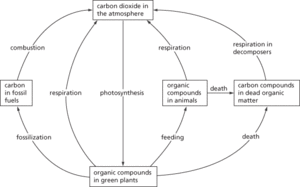A series of nuclear reactions in which four hydrogen nuclei combine to form a helium nucleus with the liberation of energy, two positrons, and two neutrinos. The process is believed to be the source of energy in many stars and to take place in six stages. In this series carbon–12 acts as if it were a catalyst, being reformed at the end of the series:
See stellar evolution.
The carbon cycle was worked out in 1938 by Hans Bethe (1906–2005) and, independently, by Carl von Weizsäcker (1912–2007).
See carbon–nitrogen cycle.
A sequence of nuclear fusion reactions in which carbon atoms act as a catalyst to convert four hydrogen atoms into one helium atom with the release of energy. The carbon cycle is the dominant energy source for ordinary stars of mass greater than about 1.5 times the mass of the Sun.
Nitrogen and oxygen are also involved in the sequence, so it is sometimes known as the carbon–nitrogen–oxygen cycle or CNO cycle.
1. One of the major cycles of chemical elements in the environment. Carbon (as carbon dioxide) is taken up from the atmosphere and incorporated into the tissues of plants in photosynthesis. It may then pass into the bodies of animals as the plants are eaten. During the respiration of plants, animals, and organisms that bring about decomposition, carbon dioxide is returned to the atmosphere. The combustion of fossil fuels (e.g. coal and peat) also releases carbon dioxide into the atmosphere. See illustration.
2. (in physics) A series of nuclear reactions in which four hydrogen nuclei combine to form a helium nucleus with the liberation of energy, two positrons, and two neutrinos. The process is believed to be the source of energy in many stars and to take place in six stages. In this series carbon–12 acts as if it were a catalyst, being reformed at the end of the series:

Carbon cycle
The series of processes in which carbon is exchanged between organisms and the atmosphere as carbon dioxide, biomass, and carbonates through the processes of photosynthesis, decomposition, and respiration.
One of the major cycles of chemical elements in the environment (see biogeochemical cycle). Carbon (as carbon dioxide) is taken up from the atmosphere, or from dissolved carbon compounds in water, and incorporated into the tissues of plants and other primary producers (e.g. phytoplankton) in photosynthesis. It may then pass into the bodies of animals as the primary producers are eaten (see food chain). During the respiration of plants, animals, and organisms that bring about decomposition, carbon dioxide is returned to the atmosphere. The combustion of fossil fuels (e.g. coal, natural gas, and peat) also releases carbon dioxide into the atmosphere. See illustration. See also greenhouse effect.

The carbon cycle in nature
The movement of carbon through the surface, interior, and atmosphere of the Earth. Carbon exists in atmospheric gases, in dissolved ions in the hydrosphere, and in solids as a major component of organic matter and sedimentary rocks, and is widely distributed. Inorganic exchange is mainly between the atmosphere and hydrosphere. The major movement of carbon results from photosynthesis and respiration, with exchange between the biosphere, atmosphere, and hydrosphere. Rates of exchange are very small, but over geologic time they have concentrated large amounts of carbon in the lithosphere, mainly as limestones and fossil fuels. This carbon was probably present as CO2 in the primordial atmosphere. The burning of fossil fuels and the release of CO2 from soil air through the clearance of tropical forests may eventually change the balance of the carbon cycle, although the climatic effects may be partly mitigated by the buffering action of the oceans; it is estimated that about 200 billion tonnes of CO2 have been added to the atmosphere in this way since 1850. See greenhouse effect.
Carbon is supplied to the biosphere as carbon dioxide during volcanic eruptions. Most of this is dissolved in the sea or built into calcareous sediments, which then form limestones and dolomites. As these rocks are folded and raised above sea level, they are subjected to solution by weak carbonic acid and form sediments once more. This is the largest and slowest of the carbon cycles. See Yuan in D. Yuan and Z. Cheng, eds (2002). The shortest cycle involves respiration by plants and animals whereby carbon dioxide is expired, and photosynthesis by plants, changing carbon dioxide and water into organic compounds. Plant species affect ecosystem carbon uptake via biomass production, and carbon release via decomposition. Dorrepaal (2007) J. Ecol. 95, 6 holds that differences in the way plants respond to climate change may feed back to the atmospheric carbon balance, and the climate at a global scale. Uncertainty in understanding the carbon cycle has significant cost implications for a climate stabilization policy, ‘with cost differences denominated in trillions of dollars’ (Smith and Edmons (2006) Tellus B 58, 5).
Since 1957, only about half of the CO2 emissions from fossil-fuel combustion have remained in the atmosphere; the rest being taken up by land and oceans. In the face of increasing fossil-fuel emissions, the rate of carbon absorption by the land and ocean has accelerated over time (Canadell et al. (2007) Proc. Nat. Acad. Sci. USA 104). There is no guarantee that the 50% discount will continue; if it disappears we will feel the full climatic brunt of CO2 emissions from fossil fuels. Climate models that include descriptions of the carbon cycle predict that terrestrial uptake of carbon will decrease in the next century as the climate warms (Miller (2008) Nature 451).
- dinucleotide
- Diocletian (245–313)
- diode
- diode detector
- diode drop
- diode forward voltage
- diode laser
- diode transistor logic
- diode-transistor logic
- diode voltage
- Diodorus Cronus
- dioecious
- Diogenes (400–c.325)
- Diogenes Laertius (3rd)
- Diogenes of Apollonia (5th)
- Diogenes of Sinope (c.400–325)
- diogenite
- diogenites
- diol
- Dione
- Dionysian
- Dionysius the Pseudo-Areopagite (c.ad 500)
- Diophantine equation
- Diophantus of Alexandria
- Diophantus of Alexandria (250)